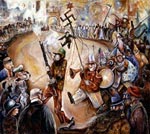
Born in 1911, Leskley painted 70 satiric watercolors while he was interned in Terezin, the show camp and ghetto established by the Nazis in Czechoslovakia. He hid them, retrieved them after the war and recreated each one. Immediately after the war, Leskley repainted all the images to provide a satiric and poignant view of the camp at Theresienstadt.
All of the following images relate to life in Theresienstadt for Jewish inmates. They reflect the high and low, the horror as well as the humor, exploitation by the Germans as well as collaborators inside the camp, disease, hunger, cold, Zionist dreams, warnings about the future of the Diaspora and other issues. All of this was in the camp labeled in the Wannsee Protocol as the "Old Age Home for the Jews," and later the model camp used for Red Cross visits and the making of the film, "The Town Hitler Made for the Jews," which was never released.








No comments:
Post a Comment